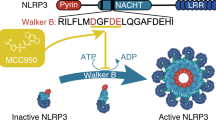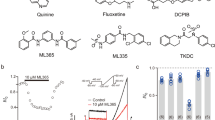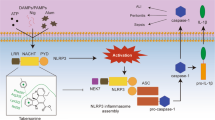Abstract
MCC950 has been proposed as a specific small molecule inhibitor that can selectively block NLRP3 inflammasome activation. However, the exact mechanism of its action is still ambiguous. Accumulating investigations imply that chloride efflux–dependent ASC speck oligomerization and potassium efflux–dependent activation of caspase-1 are the two relatively independent, but indispensable events for NLRP3 inflammasome activation. Previous studies suggested that influence of MCC950 on potassium efflux and its consequent events such as interaction between NEK7 and NLRP3 are limited. However, inhibiting chloride intracellular channel–dependent chloride efflux leads to a modification of inflammatory response, which is similar to the function of MCC950. Based on these findings, we shed new insights on the understanding of MCC950 that its function might correlate with chloride efflux, chloride intracellular channels, or other targets that act upstream of chloride efflux.

Similar content being viewed by others
References
He, Y., H. Hara, and G. Nunez. 2016. Mechanism and regulation of NLRP3 inflammasome activation. Trends in Biochemical Sciences 41: 1012–1021.
Fabio Martinon, K.B. 2002. The inflammasome: a molecular platform triggering activation of inflammatory caspases and processing of proIL. Molecular Cell 10: 417–426.
Guo, H., J.B. Callaway, and J.P. Ting. 2015. Inflammasomes: mechanism of action, role in disease, and therapeutics. Nature Medicine 21: 677–687.
Sharma BR, Karki R, Kanneganti TD. 2019. Role of AIM2 inflammasome in inflammatory diseases, cancer and infection. European Journal of Immunology.
Zhou, W., C. Chen, Z. Chen, L. Liu, J. Jiang, Z. Wu, M. Zhao, and Y. Chen. 2018. NLRP3: a novel mediator in cardiovascular disease. Journal of Immunology Research 2018: 5702103.
Sepehri, Z., Z. Kiani, M. Afshari, F. Kohan, A. Dalvand, and S. Ghavami. 2017. Inflammasomes and type 2 diabetes: an updated systematic review. Immunology Letters 192: 97–103.
Shen, H.H., Y.X. Yang, X. Meng, X.Y. Luo, X.M. Li, Z.W. Shuai, D.Q. Ye, and H.F. Pan. 2018. NLRP3: a promising therapeutic target for autoimmune diseases. Autoimmunity Reviews 17: 694–702.
Szekanecz, Z., S. Szamosi, G.E. Kovacs, E. Kocsis, and S. Benko. 2019. The NLRP3 inflammasome - interleukin 1 pathway as a therapeutic target in gout. Archives of Biochemistry and Biophysics 670: 82–93.
Perera, A.P., R. Fernando, T. Shinde, R. Gundamaraju, B. Southam, S.S. Sohal, A.A.B. Robertson, K. Schroder, D. Kunde, and R. Eri. 2018. MCC950, a specific small molecule inhibitor of NLRP3 inflammasome attenuates colonic inflammation in spontaneous colitis mice. Scientific Reports 8: 8618.
Coates, B.M., K.L. Staricha, N. Ravindran, C.M. Koch, Y. Cheng, J.M. Davis, D.K. Shumaker, and K.M. Ridge. 2017. Inhibition of the NOD-like receptor protein 3 inflammasome is protective in juvenile influenza A virus infection. Scientific Reports 8: 782.
Honda, H., Y. Nagai, T. Matsunaga, N. Okamoto, Y. Watanabe, K. Tsuneyama, H. Hayashi, I. Fujii, M. Ikutani, Y. Hirai, A. Muraguchi, and K. Takatsu. 2014. Isoliquiritigenin is a potent inhibitor of NLRP3 inflammasome activation and diet-induced adipose tissue inflammation. Journal of Leukocyte Biology 96: 1087–1100.
Lamkanfi, M., J.L. Mueller, A.C. Vitari, S. Misaghi, A. Fedorova, K. Deshayes, W.P. Lee, H.M. Hoffman, and V.M. Dixit. 2009. Glyburide inhibits the Cryopyrin/Nalp3 inflammasome. The Journal of Cell Biology. 187: 61–70.
Coll, R.C., A.A. Robertson, J.J. Chae, S.C. Higgins, R. Munoz-Planillo, M.C. Inserra, I. Vetter, L.S. Dungan, B.G. Monks, A. Stutz, D.E. Croker, M.S. Butler, M. Haneklaus, C.E. Sutton, G. Nunez, E. Latz, D.L. Kastner, K.H. Mills, S.L. Masters, K. Schroder, M.A. Cooper, and L.A. O'Neill. 2015. A small-molecule inhibitor of the NLRP3 inflammasome for the treatment of inflammatory diseases. Nature Medicine 21: 248–255.
Perregaux, D.G., P. McNiff, R. Laliberte, N. Hawryluk, H. Peurano, E. Stam, J. Eggler, R. Griffiths, M.A. Dombroski, and C.A. Gabel. 2001. Identification and characterization of a novel class of interleukin-1 post-translational processing inhibitors. The Journal of Pharmacology and Experimental Therapeutics. 299: 187–197.
Primiano, M.J., and B.A. Lefker. 2016. Efficacy and pharmacology of the NLRP3 inflammasome inhibitor CP-456,773 (CRID3) in murine models of dermal and pulmonary. Inflammation. 197: 2421–2433.
van der Heijden, T., E. Kritikou, W. Venema, J. van Duijn, P.J. van Santbrink, B. Slutter, A.C. Foks, I. Bot, and J. Kuiper. 2017. NLRP3 inflammasome inhibition by MCC950 reduces atherosclerotic lesion development in apolipoprotein E-deficient mice-brief report. Arteriosclerosis, Thrombosis, and Vascular Biology 37: 1457–1461.
Ward, R., W. Li, Y. Abdul, L. Jackson, G. Dong, S. Jamil, J. Filosa, S.C. Fagan, and A. Ergul. 2019. NLRP3 inflammasome inhibition with MCC950 improves diabetes-mediated cognitive impairment and vasoneuronal remodeling after ischemia. Pharmacological Research 142: 237–250.
Qu, J., Z. Yuan, G. Wang, X. Wang, and K. Li. 2019. The selective NLRP3 inflammasome inhibitor MCC950 alleviates cholestatic liver injury and fibrosis in mice. International Immunopharmacology 70: 147–155.
Schuh, E., C.J. Gross, D. Wagner, M. Schluter, O. Gross, and T. Kumpfel. 2019. MCC950 blocks enhanced interleukin-1beta production in patients with NLRP3 low penetrance variants. Clinical Immunology 203: 45–52.
Schroder, K., and J. Tschopp. 2010. The inflammasomes. Cell. 140: 821–832.
Shao, B.Z., Z.Q. Xu, B.Z. Han, D.F. Su, and C. Liu. 2015. NLRP3 inflammasome and its inhibitors: a review. Frontiers in Pharmacology 6: 262.
Zhang, Y., X. Lv, Z. Hu, X. Ye, X. Zheng, Y. Ding, P. Xie, and Q. Liu. 2017. Protection of Mcc950 against high-glucose-induced human retinal endothelial cell dysfunction. Cell Death & Disease 8: e2941.
Gaidt, M.M., and V. Hornung. 2018. The NLRP3 inflammasome renders cell death pro-inflammatory. Journal of Molecular Biology 430: 133–141.
Munoz-Planillo, R., P. Kuffa, G. Martinez-Colon, B.L. Smith, T.M. Rajendiran, and G. Nunez. 2013. K(+) efflux is the common trigger of NLRP3 inflammasome activation by bacterial toxins and particulate matter. Immunity. 38: 1142–1153.
Petrilli, V., S. Papin, C. Dostert, A. Mayor, F. Martinon, and J. Tschopp. 2007. Activation of the NALP3 inflammasome is triggered by low intracellular potassium concentration. Cell Death and Differentiation 14: 1583–1589.
Gov, L., C.A. Schneider, T.S. Lima, W. Pandori, and M.B. Lodoen. 2017. NLRP3 and potassium efflux drive rapid IL-1beta release from primary human monocytes during Toxoplasma gondii infection. Journal of Immunology (Baltimore, Md. : 1950) 199: 2855–2864.
Gaidt, M.M., T.S. Ebert, D. Chauhan, T. Schmidt, J.L. Schmid-Burgk, F. Rapino, A.A. Robertson, M.A. Cooper, T. Graf, and V. Hornung. 2016. Human monocytes engage an alternative inflammasome pathway. Immunity. 44: 833–846.
Fry, A.M., L. O'Regan, S.R. Sabir, and R. Bayliss. 2012. Cell cycle regulation by the NEK family of protein kinases. Journal of Cell Science 125: 4423–4433.
He, Y., M.Y. Zeng, D. Yang, B. Motro, and G. Nunez. 2016. NEK7 is an essential mediator of NLRP3 activation downstream of potassium efflux. Nature. 530: 354–357.
Shi, H., Y. Wang, X. Li, X. Zhan, M. Tang, M. Fina, L. Su, D. Pratt, C.H. Bu, S. Hildebrand, S. Lyon, L. Scott, J. Quan, Q. Sun, J. Russell, S. Arnett, P. Jurek, D. Chen, V.V. Kravchenko, J.C. Mathison, E.M. Moresco, N.L. Monson, R.J. Ulevitch, and B. Beutler. 2016. NLRP3 activation and mitosis are mutually exclusive events coordinated by NEK7, a new inflammasome component. Nature Immunology 17: 250–258.
Green, J.P., S. Yu, F. Martin-Sanchez, P. Pelegrin, G. Lopez-Castejon, C.B. Lawrence, and D. Brough. 2018. Chloride regulates dynamic NLRP3-dependent ASC oligomerization and inflammasome priming. Proceedings of the National Academy of Sciences of the United States of America 115: E9371–E9E80.
Xu, K.Y., C.Y. Wu, S. Tong, P. Xiong, and S.H. Wang. 2018. The selective Nlrp3 inflammasome inhibitor Mcc950 attenuates lung ischemia-reperfusion injury. Biochemical and Biophysical Research Communications 503: 3031–3037.
Masumoto, J., S. Taniguchi, K. Ayukawa, H. Sarvotham, T. Kishino, N. Niikawa, E. Hidaka, T. Katsuyama, T. Higuchi, and J. Sagara. 1999. ASC, a novel 22-kDa protein, aggregates during apoptosis of human promyelocytic leukemia HL-60 cells. The Journal of Biological Chemistry. 274: 33835–33838.
Gumucio, D.L., A. Diaz, P. Schaner, N. Richards, C. Babcock, M. Schaller, and T. Cesena. 2002. Fire and ICE: the role of pyrin domain-containing proteins in inflammation and apoptosis. Clinical and Experimental Rheumatology 20: S45–S53.
Awad, F., E. Assrawi, C. Louvrier, C. Jumeau, S. Georgin-Lavialle, G. Grateau, S. Amselem, I. Giurgea, and S.A. Karabina. 2018. Inflammasome biology, molecular pathology and therapeutic implications. Pharmacology & Therapeutics 187: 133–149.
Dick, M.S., L. Sborgi, S. Ruhl, S. Hiller, and P. Broz. 2016. ASC filament formation serves as a signal amplification mechanism for inflammasomes. Nature Communications 7: 11929.
Richards, N., P. Schaner, A. Diaz, J. Stuckey, E. Shelden, A. Wadhwa, and D.L. Gumucio. 2001. Interaction between pyrin and the apoptotic speck protein (ASC) modulates ASC-induced apoptosis. The Journal of Biological Chemistry. 276: 39320–39329.
Verhoef, P.A., S.B. Kertesy, K. Lundberg, J.M. Kahlenberg, and G.R. Dubyak. 2005. Inhibitory effects of chloride on the activation of caspase-1, IL-1 secretion, and cytolysis by the P2X7 receptor. The Journal of Immunology. 175: 7623–7634.
Tang, T., X. Lang, C. Xu, X. Wang, T. Gong, Y. Yang, J. Cui, L. Bai, J. Wang, W. Jiang, and R. Zhou. 2017. CLICs-dependent chloride efflux is an essential and proximal upstream event for NLRP3 inflammasome activation. Nature Communications 8: 202.
Daniels, M.J., J. Rivers-Auty, T. Schilling, N.G. Spencer, W. Watremez, V. Fasolino, S.J. Booth, C.S. White, A.G. Baldwin, S. Freeman, R. Wong, C. Latta, S. Yu, J. Jackson, N. Fischer, V. Koziel, T. Pillot, J. Bagnall, S.M. Allan, P. Paszek, J. Galea, M.K. Harte, C. Eder, C.B. Lawrence, and D. Brough. 2016. Fenamate NSAIDs inhibit the NLRP3 inflammasome and protect against Alzheimer’s disease in rodent models. Nature Communications 7: 12504.
Laliberte, R.E., D.G. Perregaux, L.R. Hoth, P.J. Rosner, C.K. Jordan, K.M. Peese, J.F. Eggler, M.A. Dombroski, K.F. Geoghegan, and C.A. Gabel. 2003. Glutathione s-transferase omega 1-1 is a target of cytokine release inhibitory drugs and may be responsible for their effect on interleukin-1beta posttranslational processing. The Journal of Biological Chemistry. 278: 16567–16578.
Domingo-Fernandez, R., R.C. Coll, J. Kearney, S. Breit, and L.A.J. O'Neill. 2017. The intracellular chloride channel proteins CLIC1 and CLIC4 induce IL-1beta transcription and activate the NLRP3 inflammasome. The Journal of Biological Chemistry. 292: 12077–12087.
Argenzio, E., and W.H. Moolenaar. 2016. Emerging biological roles of Cl- intracellular channel proteins. Journal of Cell Science 129: 4165–4174.
He, G., Y. Ma, S.Y. Chou, H. Li, C. Yang, J.Z. Chuang, C.H. Sung, and A. Ding. 2011. Role of CLIC4 in the host innate responses to bacterial lipopolysaccharide. European Journal of Immunology 41: 1221–1230.
Funding
This work was supported by the National Natural Science Foundation of China (No. 81873130, No. 81573733, No. 81804025), Tianjin Municipal Natural Science Foundation (No. 18JCYBJC94500), Scientific and Technological Research Program of Tianjin Municipal Education Commission (No. 2017KJ164), and 2017 Annual Graduate Students Innovation Fund (School of Integrative Medicine, Tianjin University of Traditional Chinese Medicine, Tianjin, China; No. CXJJLX201701).
Author information
Authors and Affiliations
Corresponding authors
Ethics declarations
Conflict of Interest
The authors declare that they have no conflict of interest.
Additional information
Publisher’s Note
Springer Nature remains neutral with regard to jurisdictional claims in published maps and institutional affiliations.
Rights and permissions
About this article
Cite this article
Wu, D., Chen, Y., Sun, Y. et al. Target of MCC950 in Inhibition of NLRP3 Inflammasome Activation: a Literature Review. Inflammation 43, 17–23 (2020). https://doi.org/10.1007/s10753-019-01098-8
Published:
Issue Date:
DOI: https://doi.org/10.1007/s10753-019-01098-8




